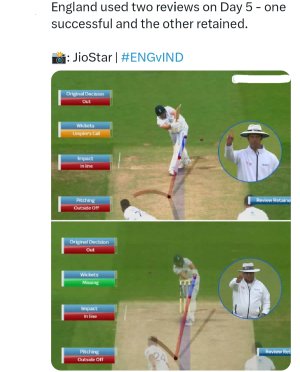The hard truths that show England will struggle to win the Ashes
For all the
courage of Chris Woakes, the class of Joe Root and the outlandish skill of Harry Brook, a memorable final Test between England and India at the Oval came with the reality that Bazball will land in Australia without a major victory of any sort to show for it.
England coach Brendon McCullum and his injured captain Ben Stokes – who did all the pre- and post-game media in place of the anonymous stand-in skipper Ollie Pope – spoke floridly of the 2-2 encounter against Shubman Gill’s side as among the best Test series they had lived through.
“From a cricket fan’s point of view, 2-2 is probably fair,” Stokes said. “Two very good teams who have thrown everything at each other and left everything out there. We obviously would have loved to get a series win, but it wasn’t meant to be.
“There’s a little bit of frustration there as well, but as a massive advocate of this format and for Test cricket as a whole, this has certainly been one of those series that could hopefully keep off the narrative around ‘Test cricket is dying’.”
That’s a warm note to take from a battle that entranced followers around the world at a time of year when there is very little competition for cricket eyeballs. But the former captain Nasser Hussain gave a more clipped assessment of how things had panned out. A 3-1 England win would have been a “travesty”, he said.
It is worth remembering that this was the series in which England were meant to have evolved from entertainers to winners.
They had become more pragmatic in tactics,
more inclined to sledge opponents on the field, and more susceptible to the petulance that followed India’s series-saving rearguard in Manchester. Putting on a show was no longer enough.
All those changes were, however, largely cosmetic next to a couple of hard cricket truths. First, winning big series generally requires keeping your best fast bowlers fit, something England have consistently failed to do over many years, not just during the Bazball era that began in 2022.
While Woakes’ dislocated shoulder in the field was truly a freakish occurrence, he was the only remaining member of the bowling attack that had started the series. Stokes’ shoulder is now in a terrible state a little over three months before the first Ashes Test;
Jofra Archer still has a long way to go to be back to his best, and Mark Wood is also still in rehab mode.
Australia’s major strength is still the quality and durability of their bowling attack. Pat Cummins, Mitchell Starc, Josh Hazlewood and Scott Boland can all be expected to be fit for the start of the Ashes, and almost as likely to remain so for its duration. England have no record at all of doing similar, and will struggle to win a Big Three series (against Australia or India) until they can.
The second conclusion to take from the Oval is that, Root and Brook’s brilliant day four partnership aside, Bazball is far harder to carry off on a pitch that gives the bowlers some help. With the ball swinging, seaming and lifting in the hands of Mohammed Siraj and Prasidh Krishna, England’s breakout star Jamie Smith looked completely unable to counter: he will get more of that in Australia.
Over the past four summers, Cummins’ team have thrived on making the most of pitches that offer them movement, while the harried Australian batting lineup does just enough to get the runs that their bowlers require to defend.
Those runs came last summer against India despite having to contend with
Jasprit Bumrah at his absolute best. England had a chance to size up Bumrah soon after his recovery from back surgery, and on flatter pitches too. India could not use Bumrah as freely as they had tried to in Australia, leaving Siraj to have the final word at the Oval.
Root and Brook are clearly players of top quality, and their stand on day four is worthy of high praise for the sporting surface on which it took place.
But Australia will be confident that they can ask similar questions to Siraj over long periods, benefiting from the balance provided
by the spin of Nathan Lyon and the all-round capabilities of Cameron Green and Beau Webster. Vice-captain Pope, a skittish presence at number three, will be one obvious target.
The identity of England’s spin bowler has been made no clearer by a series in which Shoaib Bashir was injured, Liam Dawson discarded and Jack Leach never called upon.
Nevertheless, England will take one thing to Australia that some of their forebears struggled to maintain down under – a strong sense of unity. Woakes’ decision to walk out to the middle with his left arm in a sling, helping Gus Atkinson get the hosts to within six runs of winning the series, is the sort of moment that shows character.
Beyond Bazball’s often silly rhetoric,
the posturing about saving Test cricket and the outlandish selection choices, there is a greater sense of shared purpose about the England Test side. That sort of thing is never tested more severely than on an Ashes tour of Australia. But this England does stand a chance of holding together.







 so there's no point in us speculating too much
so there's no point in us speculating too much
